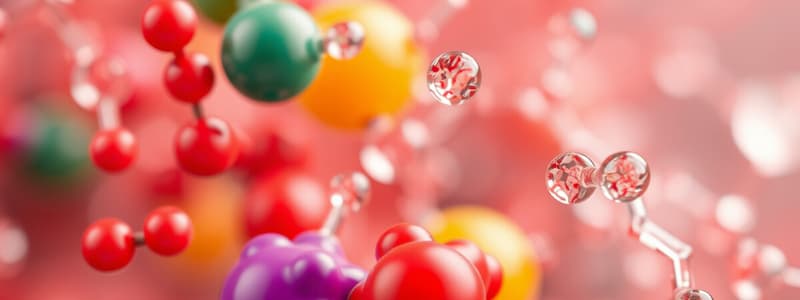Podcast
Questions and Answers
Match the following enzymes to their optimal pH:
Match the following enzymes to their optimal pH:
Amylase = pH 7 Pepsin = pH 2 Lipase = pH 10 Trypsin = pH 8
Match the following terms to their definitions:
Match the following terms to their definitions:
Denatured = Loss of enzyme shape and activity Co-enzymes = Helper substances for enzyme function Substrate = The substance on which an enzyme acts Inhibitors = Substances that decrease enzyme activity
Match the following environmental factors to their effects on enzymes:
Match the following environmental factors to their effects on enzymes:
Temperature above 40°C = Enzyme denaturation Optimal temperature around 37°C = Maximized enzyme activity Low pH = Inhibition of certain enzymes High substrate concentration = Possible saturation of enzyme activity
Match the following enzymes to their primary functions:
Match the following enzymes to their primary functions:
Match the following enzymes with their source:
Match the following enzymes with their source:
Match the following vitamins to their role as co-enzymes:
Match the following vitamins to their role as co-enzymes:
Match the following factors affecting enzyme activity with their specific effects:
Match the following factors affecting enzyme activity with their specific effects:
Match the following enzymes to their respective digestive systems:
Match the following enzymes to their respective digestive systems:
Match the enzyme activity factor with its effect:
Match the enzyme activity factor with its effect:
Match the process with the example:
Match the process with the example:
Match the type of reaction with its description:
Match the type of reaction with its description:
Match the term with its definition:
Match the term with its definition:
Match the substance with its function:
Match the substance with its function:
Match the biological change with the condition:
Match the biological change with the condition:
Match the type of reaction with its example:
Match the type of reaction with its example:
Flashcards are hidden until you start studying
Study Notes
Enzymes Overview
- Enzymes are proteins that act as biological catalysts, accelerating chemical reactions without being consumed.
- Each enzyme is specific to one substrate and produces only a specific set of products.
- Made from long chains of amino acids linked by peptide bonds; their structure is folded into a unique 3D shape.
Co-enzymes
- Some enzymes require additional molecules, known as co-enzymes, for optimal function.
- Co-enzymes are organic, non-protein substances; vitamins B1 and B6 function in this role.
- Enzyme names typically end with the suffix ‘-ase’.
Factors Affecting Enzyme Activity
- Enzyme function is influenced by environmental conditions such as pH, temperature, concentration of enzymes, and substrates, as well as the presence of inhibitors.
pH Impact
- Each enzyme has a specific pH range for optimal activity:
- Amylase: best at pH 7 (neutral).
- Pepsin: functions optimally around pH 2 (acidic), suited for the stomach.
- Lipase: works best at pH 10 (alkaline) in the small intestine.
Temperature Impact
- Enzyme activity typically increases with temperature, peaking at around 40°C.
- Above 40°C, enzymes rapidly denature, losing shape and function.
- Human enzymes function optimally around 37°C but can become inactive above this temperature, particularly in the brain, risking seizures.
- Plant enzymes thrive at an approximate optimum temperature of 25°C.
Denatured Enzymes
- Denaturation refers to the loss of an enzyme's shape and activity, caused by several factors:
- High Temperature: Enzymes lose shape above 40°C; irreversible changes occur at temperatures exceeding 50°C. For example, egg whites transition from clear to stiff upon heating.
- pH Change: For instance, salivary amylase, which breaks down starch at pH 7-8 in the mouth, becomes inactive when exposed to the acidic environment (pH 1) in the stomach.
- Agitation: Physical mixing or beating can alter enzyme shape and activity, such as when egg whites are beaten, forming a thick mixture that traps sugar.
Active Site Theory
- The active site is the specific region on the enzyme where the substrate binds and reactions occur.
- The binding causes slight shape changes in both substrate and enzyme, forming an enzyme-substrate complex.
- These transformations facilitate product formation and lower activation energy needed for the reaction.
- Resulting products may form a substrate-product complex, allow the enzyme to revert to its original shape, ready to catalyze another reaction.
Types of Reactions
- Anabolic Reactions: Create more complex products from simpler reactants; e.g., muscle formation.
- Catabolic Reactions: Break down complex reactants into simpler products; oppositely, they release energy.
Studying That Suits You
Use AI to generate personalized quizzes and flashcards to suit your learning preferences.




